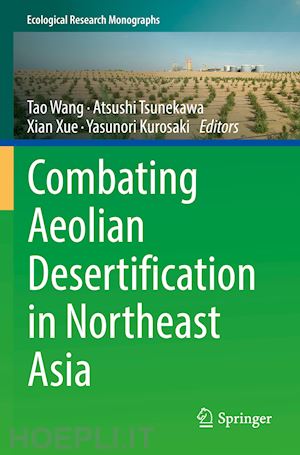
Questo prodotto usufruisce delle SPEDIZIONI GRATIS
selezionando l'opzione Corriere Veloce in fase di ordine.
Pagabile anche con Carta della cultura giovani e del merito, 18App Bonus Cultura e Carta del Docente
Aeolian desertification in Northeast Asia is of great concern for its destructive influences on the environment and society not only in the local but also in faraway areas. The topics of this book are addressed by compiling theoretical review, remote sensing monitoring, synoptic analysis, and laboratory and field studies in China, Japan, and Mongolia.
This is the first comprehensive book to address the aeolian desertification in Northeast Asia. Readers can learn the basic theory of aeolian desertification and the primary causes of this environmental problem. More critical is the successful practical countermeasures to combat desertification which can be referred to by various stakeholders who concern the aeolian desertification in Northeast Asia.
To meet the Sustainable Development Goals of the United Nations adopted in 2015, especially its Goal 15.3 to achieve a land degradation-neutral world by 2030, desertification combating actions should be taken cross country borders. This book is not only intended for environmental professionals but also for people who are affected and concerned about desertification and land degradation. The concept and processes in this book will serve as a ready reference to understand the aeolian desertification with countermeasures and successful preventing stories that can be referred to.
Chapter 1. Definition of Aeolian Desertification and its Implications.- Chapter 2. Environmental and Ecological Setting in Northeast Asia.- Chapter 3. Spatial Distribution and Temporal Dynamics of Aeolian Desertification.- Chapter 4. Driving Factors of Aeolian Desertification.- Chapter 5. Aeolian Desertification Processes.- Chapter 6. Impacts of aeolian desertification and dust storms on ecosystems, economic development, and human health.- Chapter 7. Goals and Principles for Combating Aeolian Desertification.- Chapter 8. Engineering Measures to Combat Aeolian Desertification.- Chapter 9. Biological Measures to Combat Aeolian Desertification.- Chapter 10. Integrated System to Combat Aeolian Desertification and Disasters.- Chapter 11. Land Management Policies for Sand-Dust Storm and Aeolian Desertification in Source Region Countries.- Chapter 12. Successful Implementation of Measures to Combat Aeolian Desertification in China.- Chapter 13. Implementation of Measures to Combat Aeolian Desertification in Mongolia.- Chapter 14. Sustainable Land Management to Combat Aeolian Desertification.
Atsushi Tsunekawa is a professor at Arid Land Research Center, Tottori University (Japan). He graduated from the Graduate School of Agricultural Sciences, University of Tokyo, after which he joined the National Institute for Environmental Studies, Japan. Currently, he serves as a professor at the Arid Land Research Center, Tottori University, and also serves as a head of Strategic Management Office of International Platform for Dryland Research and Education, Tottori University. His primary scholarly interests are developing sustainable land management (SLM) technologies and approaches to restore degraded land and improve farmers’ livelihood, and monitoring and modelling of terrestrial ecosystems under climate change using remote sensing and GIS. He has been selected as a Science and Technology Correspondent from Japan to the Committee on Science and Technology of United Nations Convention to Combat Desertification.
Xian Xue is a professor at Northwest Institute of Eco-Environment and Resources (NIEER), Chinese Academyof Sciences. She obtained her PhD in physical geography from the Graduate School at the Chinese Academy of Sciences in 2002. As the head, she currently leads the Department of Desert and Desertification in the NIEER, the Dryland Salinization Station of NIEER, and the Salinization Research Station of Gansu Province. Prof. Xue’s main research fields are desertification and restoration, and climate and environmental change in arid and cold regions. Her interest focuses on the dynamic process and mechanism of desertification and its rehabilitation. One of her current research is exploring the impact of global warming and human activity on land degradation in the arid and alpine ecosystems. Her other work is to explore restoration possibilities of degraded land in the drylands by integrating water management, sustainable agriculture, and biological techniques with her team.
Yasunori Kurosaki is a professor at Arid Land Research Center (ALRC), Tottori University, Japan. He obtained his PhD from Graduate School of Life and Environmental Sciences, University of Tsukuba. His main research theme is elucidation of the aeolian dust emission mechanisms. Prof. Kurosaki began his research at the Meteorological Research Institute, Japan Meteorological Agency, in 2001, and he has continued it at Chiba University, Georgia Institute of Technology, and Tottori University. He has elucidated the causes of aeolian dust emission that change with time and place in drylands of Northeastern Asia mainly by analyzing meteorological observatory data and GIS data such as satellite data. He has also studied it by field surveys in the Gobi Desert. His interest and the purpose of his research are to apply his elucidated mechanisms to improve numerical aeolian dust models and to prevent wind erosion and aeolian dust damage.











Il sito utilizza cookie ed altri strumenti di tracciamento che raccolgono informazioni dal dispositivo dell’utente. Oltre ai cookie tecnici ed analitici aggregati, strettamente necessari per il funzionamento di questo sito web, previo consenso dell’utente possono essere installati cookie di profilazione e marketing e cookie dei social media. Cliccando su “Accetto tutti i cookie” saranno attivate tutte le categorie di cookie. Per accettare solo deterninate categorie di cookie, cliccare invece su “Impostazioni cookie”. Chiudendo il banner o continuando a navigare saranno installati solo cookie tecnici. Per maggiori dettagli, consultare la Cookie Policy.